
Lab Campaign Emphasizes
Safety
Lab Campaign Emphasizes Safety
BY RON KOLB
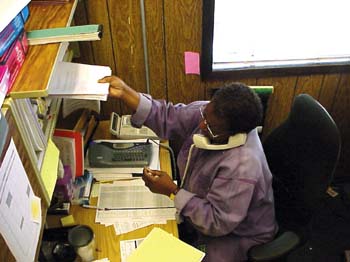 |
|
| Employees who hold their phones like this may experience neck and shoulder pain. To avoid injury, consider using a headset during extended phone conversations. |
It is easy to become consumed by statistical measures and comparisons, not all of which are necessarily accurate or fair. You can look at Berkeley Lab’s Total Recordable Accident (TRC) rate of 2.3 (incidents per 200,000 hours worked) in FY2003 a couple of ways. On a national scale for R&D facilities, it is about average. But compared with what other Department of Energy science labs report, it is the highest injury rate.
That doesn’t tell the whole story, of course. The Lab’s Integrated Safety Management Program has earned deserved praise and remains strong, and the Lab’s general reduction in accidents has been notable. Nonetheless, Office of Science statistics tell a somewhat different story, and that agency has aggressive goals for improvement.
There’s no better time to launch an accident awareness campaign than now, as we enter the most injury-prone period of the year. In case that’s not incentive enough, about 20 members of the Occu-pational Safety and Health Agency (OSHA) will be doing a two-week safety audit here beginning next Monday (see sidebar). Thus Deputy Director for Operations Sally Benson is calling for an all-hands commitment to reducing the accident rate.
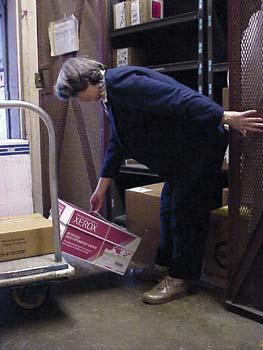 |
|
| Lifting improperly, as pictured left, can cause back injury. | |
“First and foremost, we care about the health and well-being of every employee,” she said. “Workplace injuries and illnesses can have lasting impacts on an employee’s health. Most workplace injuries and accidents are preventable, which makes these impacts tragic. Accident and illness prevention is a responsibility shared by employee, managers and the institution as a whole.”
Tradition and statistics show the months of February, March and April as the highest-incident period of the year at Berkeley Lab. For example, during this period last year, Lab workers experienced 20 recordable injuries, including seven acute strains (while lifting or tripping), five lacerations, and six repetitive motion injuries (mostly computer-related). The cost estimate to the Lab for those injuries was $230,000.
So attention to safety is being ratcheted up. Benson’s Operations is taking the lead, requiring safety training of its managers and tailoring intervention strategies to the departments with historically the most incidents. Weekly safety reviews of recordable accidents have been conducted since November.
“A little over half the accidents are concentrated in three divisions,” said acting Environment, Health and Safety Division Director Robin Wendt. “Ergonomic accidents (repetitive strain injuries) comprise about one-third of them. Research activities only account for one-fourth of the accidents and one-eighth of lost workdays. So our focus is on operations.”
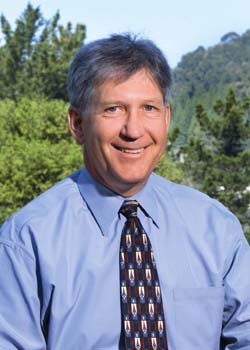 |
|
| Robin Wendt | |
And the focus, Wendt said, will be on the three areas whose nature of work is the most high-risk and which account for more than half the recordable accidents at Berkeley Lab – facilities, administrative services, and engineering.
Medical Services Director Dr. Peter Lichty suggests a series of measures for employees to start the safety year off right:
- Make sure computer workstations are properly configured. If in doubt, request an ergonomic evaluation via the EH&S website
- Take care moving around the site, especially on stairs. Allow enough time to avoid running.
- Consider taking Berkeley Lab’s back injury prevention course.
- Managers can help by walking through their work areas and looking for hazards or hazardous work practices.
- Maintain good housekeeping to avoid trip hazards.
- Report safety hazards to management for correction.
 |
|
| Cutting in this manner, above, is dangerous and can cause lacerations to hands and fingers. |
The EH&S Division website has a link for suggestions on ways to improve safety at the Lab. Comments can be submitted anonymously via an online form or, if a response is desired, by including an e-mail address.
Wendt said he’d like to see that TRC rate cut in half for this fiscal year. So far, so good. In the first three months of FY04, only five accidents met the “recordable” threshold at the Lab. “We’re off to a good start,” he said, “but now we have to keep the accident rate low.”
Accountability will be increased, too, as the annual Performance Review and Development (PRD) process will give supervisors and managers stricter evaluations in the area of safety. Also, industry “best practices” will be brought to bear, as appropriate, on Laboratory policies. “Lessons learned” will be passed on to employees via Lab communications tools like “Today at Berkeley Lab.”
Wendt has even come up with a slogan that seems most applicable: “Like the old Hill Street Blues guy said, ‘Let’s Be Careful Out There.’”
OSHA to Conduct Compliance Audits
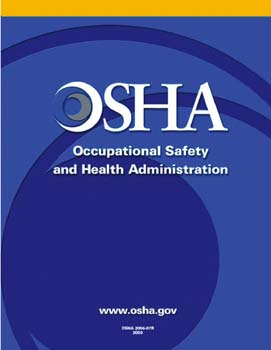 |
|
This is all preliminary to potential “external regulation” of the Department of Energy science labs by the federal OSHA organization. Right now, the labs are accountable to DOE policies, procedures, and other standards in this area. In July 2002, the DOE was directed by Congress to estimate the cost to bring 10 Office of Science labs, including Berkeley Lab, into compliance with OSHA standards.
“The audit will be conducted by about 20 OSHA representatives between January 12 and 23,” said Robin Wendt, Berkeley Lab’s acting division director of Environment, Health and Safety. “The focus will be health and safety requirements in every square foot of Laboratory, shop and construction activities. The OSHA auditors then recently announced their intention to inspect some office spaces.”
OSHA will conduct the audit by divisions, with the divisional safety
coordinators acting as liaisons and escorts. Wendt noted that OSHA
is to generally be provided access to all rooms, and that divisions
do self-assessments and housecleaning prior to their arrival. A list
of safety coordinators can be found at http://www.lbl.gov/ehs/html/
coordinators.shtml.
Congress has set aside $10 million a year for three years to correct deficiencies in science lab safety programs. OSHA has already audited Argonne, Brookhaven and Oak Ridge labs.
Bike Commuters Find Uphill Battle Enjoyable
BY D. LYN HUNTER
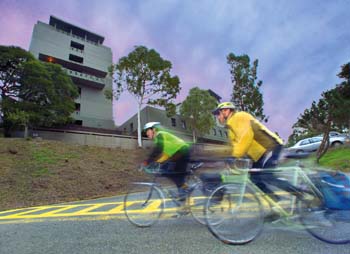 |
|
| John Seabury, left, and Steve Greenberg tackle Cyclotron Road’s steep incline. | |
Why would anyone in their right mind want to ride their bike up the Lab’s hills every morning? Many employees ask this question from the comfort of their cars or the shuttle bus as they pass cyclists who pedal their way to work each day. But this intrepid group of two-wheeled commuters wouldn’t have it any other way.
John Seabury, with Environment, Health and Safety, and Steve Greenberg, with Facilities, are among the numerous employees who use bicycles to attack the nearly 1,000-foot inclines around the Lab.
“Driving is such a pain,” says Seabury bluntly. “Biking takes some patience and perseverance, but it’s a great time to get some thinking done.”
Says Greenberg: “It’s a wonderful way to wake up, get your blood flowing, and prepare for the day. Plus, I never have to worry about trying to find a parking space here at the Lab.”
As a Berkeley resident, it only takes Greenberg about 20 minutes
to ascend Cyclotron and Alvarez Roads to his office in Building 90.
It’s a bit more complicated for Seabury, who lives in Davis.
He loads his bike onto an Amtrak train at 5:45 a.m., disembarks in
Emeryville, and then rides up to the Lab through Kensington and the
Grizzly Peak gate.
To the uninitiated, this uphill battle looks like a painful process,
but it doesn’t hurt a bit, say both Greenberg and Seabury.
“Of course, you have to build up your muscles,” explains Seabury, “but once that’s achieved, it’s like any other form of exercise. Plus, modern bicycles and their multiple gears make it a lot easier.”
“Some people go the gym,” adds Greenberg. “We do this instead.”
Anyone would admit biking is a great form of exercise, but sharing the road with two-ton automobiles — and, on occasion, wildlife such as deer — can be treacherous. But virtually every mishap Greenberg and Seabury say they’ve had has been their fault.
“By and large, most drivers are very considerate and give us a wide berth,” says Greenberg. “Normally, we are our own worst enemies, especially when we don’t adjust to road conditions, travel too fast, or just don’t pay attention.”
While the morning commute requires copious amounts of energy, strength
and patience, the ride home, by contrast, is a breeze. Whizzing down
the hill — reaching speeds up to 25 miles-per-hour — is
an exhilarating experience, say Greenberg and Seabury.
“I can have a totally bad day at work,” says Greenberg,
“but blasting down that hill puts me in a whole different frame
of mind.”
Seabury and Greenberg say they would be happy to speak with Lab employees interested in commuting by bicycle.
Life Adjustments for 2004
Though Julius Caesar moved New Year’s Day to Jan. 1 in 46 B.C., the ritual of making resolutions has continued. But instead of returning farm equipment, people today make “life adjustments” that fit our modern lifestyle, such as exercising more or quitting smoking.
The editors of The View polled various employees at the Lab to see what kind of changes they had in store for 2004. Here’s a sampling:
“Well, I’m not one for making New Year’s resolutions,
but I do have a personal goal to lose 20 pounds.”
Bill Elkins — Human Resources
“Spend more time with my two godsons, Christian and Daniel.
They live in Pinole and I’m moving to Berkeley from Novato,
so it ought to be a lot easier to do!”
Valerie Quigley — Environment, Health and Safety
“One of my frequent New Year’s resolutions is to try
to make it to the Lab’s yoga classes on a regular basis. It’s
a great way to get re-energized.”
Rick Diamond — Environmental Energy Technologies
“Take better care of myself both physically and mentally, spend
more time with my family, read and write more, and travel somewhere
fun and exciting.”
Nina Lucido — Administrative Services
“Breathe in…breathe out…breathe in…breathe
out…breathe in…breathe out…”
Steve Wiel — Environmental Energy Technologies
“Maintain an orderly desktop.”
Mike Chartock — Planning and Development Director
“ ‘Put theory into action’ kind of sums up my various
resolutions.”
Jane Baynes — Operations
“My resolution for 2004 is to ski 175 days.”
Don Bell — Environment, Health and Safety
“Work less, play more, say yes to my kids whenever possible!”
Marilee Bailey — Technical and Electronic Information
“My office is a mess, and I resolve to clean and organize everything
in it.”
Eugene Schultz — Information Technology Services
“Not get so mad at my beloved Packers when they lose, drive
more courteously on my monster of a motorcycle, convince others to
change their rude behavior, and take better care of myself.”
Robin Wendt — Operations
“Spend more time with my family and friends, improve my golf
game, and finish my wife’s ‘honey do’ list. I also
resolve to start and finish at least one home improvement project
each month.”
James Murphy — Facilities
“I’ve resolved to keep a neater desk.”
Moira Howard-Jeweler — Lab Washington D.C. Projects Office
Lab Opens Homeland Security Office
BY RON KOLB
 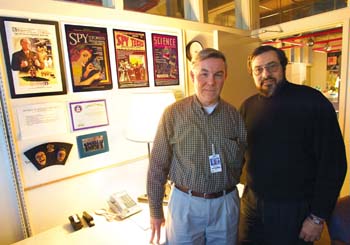 |
|
| Henry Rutkowski (left) and William Barletta in the Building 50 hub for the new Homeland Security Office. | |
What’s in a name? For Berkeley Lab’s new Office of Homeland Security, it could be an enhanced role in research that helps to address America’s terrorist threat.
Over the past two years, various Laboratory researchers have engaged in work that directly addresses national needs in areas like chemical and biological agent detection and transport. But the Lab has not yet been recognized along with other Department of Energy facilities as a full partner in homeland security science.
“We hope it will make people in the national security arena more aware of the basic science capabilities here and the cutting-edge talent that can be brought to bear on the terrorist threat.”
With the establishment in December of the new Office of Homeland Security here, Berkeley Lab hopes to organize the various contributing research units into a focused program that will attract support from federal agencies.
“We believe that our unique capabilities and our national resources, plus our commitment to this vital work, will bring us that recognition,” said the office’s director, William Barletta. “We have powerful links to our nation’s university and industrial research community, and we bring unique intellectual and physical resources to our efforts.”
The new office is divided into six research departments, with a charter to develop and conduct interdivisional programs based on laboratory capabilities of relevance to homeland security problems. Some 70 different scientists currently pursue such research here in more than a dozen separate programs.
“We now have one established point of contact as a focal point for agencies involved in this work,” said Barletta’s deputy, Henry Rutkowski. “We hope it will make people in the national security arena more aware of the basic science capabilities here and the cutting-edge talent that can be brought to bear on the terrorist threat.”
Rutkowski was quick to point out, however, that all work related to homeland security at Berkeley Lab will continue to be unclassified, and that no high-risk agents — or gases — will be brought to the Lab as part of the studies.
“Even the Department of Homeland Security (in Washington) has said it wants to keep its technology unclassified as much as possible,” Rutkowski added. “It’s all about sharing information and putting the tools in the hands of the first responders.”
Berkeley Lab is especially strong in capabilities such as indoor air transport science and technology, chem-bio characterization and detection, radioactivity detection technology, and development of radiation sources for active interrogation of cargo shipments.
Of special note are the Lab’s national user facilities, which include the Advanced Light Source, the National Center for Electron Microscopy, the Joint Genome Institute, the Molecular Foundry, and the National Energy Research Scientific Computing Center. According to Barletta, benefits range “from the immediate, such as forensic analysis of trace contaminants, to opening the doors on the rapidly expanding fields of applied genomics and nanotechnology.”
He also emphasized the value that the Lab’s affiliation with University of California campuses, especially Berkeley, brings to the portfolio.
The Office of Homeland Security will have several key functions, including coordinating Lab participation in Department of Homeland Security (DHS) activities here and with other DOE labs, supporting proposals and projects, maintaining communications with the DHS, and developing strategic partnerships with other agencies. Project proposals will continue to generate from the home divisions through the new office’s research departments.
The office reports directly to Lab Director Charles Shank. In addition to their directing roles, Barletta and Rutkowski will continue to serve as director and deputy, respectively, in the Accelerator and Fusion Research Division.
The six research areas under which homeland security work will be housed, with their lead scientists:
- Chem/Bio Countermeasures
Gary Andersen of Earth Sciences and Rich Sextro of Environmental Energy Technologies (EETD) - Rad/Nuclear Countermeasures
Lee Schroeder of Nuclear Science - Threat Assessment and System Analysis
Barletta and Rutkowski - Transportation and Border Security
Rick Gough of Accelerator and Fusion Research (AFRD) and Victor Karpenko of Engineering - Information and Critical Infrastructure
Sandy Merola of Information Technologies and Services (ITSD) - Emergency Preparedness
Reid Edwards of Public Affairs
Lifan Wang’s Journey Follows a Long Astronomical Tradition
BY PAUL PREUSS
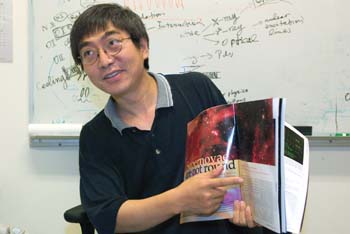 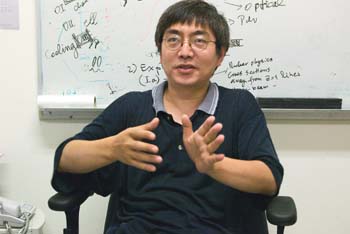 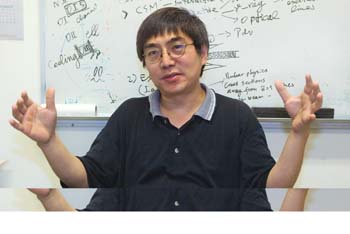
|
|
| Lifan Wang |
Chinese astronomers have been recording supernovae as far back as 386 C.E., including the supernova of 1054, precursor of the Crab Nebula. Lifan Wang of the Physics Division has added new luster to this 1,600-year-old tradition.
Wang and his colleagues discovered the spectacular rings around supernova 1987A while he was a graduate student at the European Southern Observatory (ESO). As a postdoc at the University of Texas at Austin, Wang pioneered supernova spectropolarimetry, the most powerful tool for studying stellar explosions in 3-D.
Wang grew up in China’s heartland, Shaanxi Province, recently famous for its buried army of ceramic warriors. His father, now an attorney, was a government official after the war but was demoted to grade-school administration during the Cultural Revolution, which lasted until young Lifan was 11. As a child, Wang remembers, “the propaganda was such that all kids studied science.”
The fiercest college competition was for the Chinese Academy of Sciences’ University of Science and Technology of China (USTC) in Anhui Province. Wang was one of only five students admitted from Shaanxi. Despite a “romantic interest in the philosophical questions of cosmology,” he majored in electrical engineering.
After receiving his undergraduate degree, however, he became a student of the noted astrophysicist Lizhi Fang. “USTC was unique,” Wang explains. “Anyone who graduated could get into graduate school in any field.” He followed Fang from USTC to the Beijing Astronomical Observatory; there he first put his eye to a major telescope. It was a time “when cosmology was just becoming real physics.”
For Wang, 1989 was an eventful year personally, politically, and astronomically. In Beijing he and Yuanjing Xu, a mathematician he had met at USTC, were married. Meanwhile China’s democracy movement was racing toward a climax at Tiananmen Square. In June Lizhi Fang, an outspoken advocate of reform, was forced to seek asylum in the U.S. embassy, later emigrating to the West.
Lifan Wang had been invited to continue graduate work at the ESO,
and he and his bride moved to Germany. There he worked gathering data
on the brand-new supernova 1987A for ESO’s Joseph Wampler. In
December, at the New Technology Telescope in Chile, Wang’s team
discovered 1987A’s rings.
The next few years were peripatetic, taking Wang from ESO to Manchester University and then back to China, where he published a Nature letter on the shape of SN 1987A. In 1994 he received a joint Ph.D. from USTC and ESO. While delivering a talk at an International Astronomical Union symposium in Beijing he met supernova theorist J. Craig Wheeler from the University of Texas.
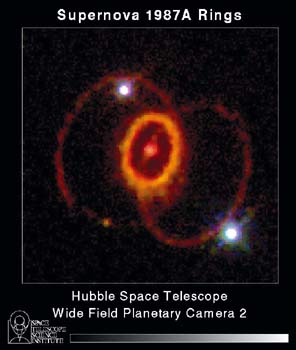 |
|
| The rings around supernova 1987A, discoverd by Lifan Wang and colleagues at the European Southern Observatory, were later made famous by the newly-launched Hubble Space Telescope. | |
Wang joined Wheeler as a postdoc at UT. They planned the first systematic program of supernova spectropolarimetry, for which Wang received a Hubble Fellowship from NASA in 1996. Using a small but stable telescope at the McDonald Observatory in West Texas, he and his colleagues soon compiled a momentous list: polarimetry measurements showed a clear difference between core-collapse supernovae, formed from massive stars, and Type Ia supernovae — the bright “standard candles” used to measure the expansion of the universe — whose progenitors are white dwarfs. Core-collapse supernovae were clearly polarized, indicating asymmetric explosions, but Type Ia polarization was puzzlingly slight.
In 2001 Wang and his wife and daughter moved to the Bay Area. Yuanjing Xu had been offered a position with a major software company, and Wang found a welcome at the Supernova Cosmology Project and the Nearby Supernova Factory based at Berkeley Lab. Wang maintains close ties with astronomers at ESO and the University of Texas — including the Supernova Cosmology Project’s rivals in measuring the expansion of the universe.
Wang’s discoveries, including the first measurement of asymmetry in a Type Ia supernova, have benefited both camps. He continues to study 1987A, “the only supernova whose shape we can actually resolve.” More discoveries are sure to come; as Wang points out, “spectropolarimetry is still a rapidly growing field.” And he is that field’s recognized leader.
DOE Announces Major INCITE Allocations of NERSC Resources
BY JON BASHOR
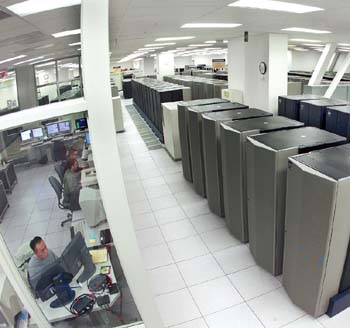 |
|
Three key computational science projects, including one at Berkeley Lab, will be allocated a total of 4.9 million hours of supercomputing time at NERSC, the Department of Energy’s Office of Science announced on Dec. 23. The projects — in astrophysics, fluid turbulance, and photosynthesis — were selected under a new competitive program entitled Innovative and Novel Computational Impact on Theory and Experiment (INCITE), announced last July. The awards amount to 10 percent of the total computing time available this year on NERSC’s current IBM supercomputer.
“From the outset, our goal was to develop scientific discovery through high end computation,” Energy Secretary Spencer Abraham said. “The number and quality of the proposals we received show that this promise is shared by our colleagues in the scientific community world-wide.”
The three projects selected by INCITE are:
- Thermonuclear Supernovae: Stellar Explosions in Three Dimensions, led by Tomasz Plewa of the Center for Astro-physical Thermonuclear Flashes at the University of Chicago. A collaboration between scientists at the university and at Argonne National Laboratory, the project studies the long-standing problem of thermonuclear flashes on the surfaces and interiors of compact stars, which will shed light on a variety of fundamental questions in astrophysics.
- Fluid Turbulence and Mixing at High Reynolds Number, led by P. K. Yeung of the Georgia Institute of Technology. With improved modeling capability of fluid turbulence, scientists will gain greater insight into areas such as meteorology, astrophysics, oceanography, environmental quality, and combustion and propulsion.
- Quantum Monte Carlo Study of Photoprotection via Carotenoids in Photosynthetic Centers, led by William A. Lester, Jr. of Berkeley Lab and UC Berkeley. The project aims
to increase understanding of the complex processes which occur during photosynthesis through Monte Carlo statistical simulations.
The projects were selected from 52 proposals submitted. Along with the computing time, NERSC will make petabyte storage capability and high-performance networking and visualization resources available.
The Hunt for Hydrates
BY DAN KROTZ
Earth Sciences Division scientists Tim Kneafsey, Barry Freifeld, Liviu Tomutsa and Yongkoo Seol have devel-oped some of the world’s largest laboratory samples of methane hydrate in porous media, a feat that could help researchers determine how to best extract the vast quantities of natural gas hidden under the world’s oceans and permafrost.
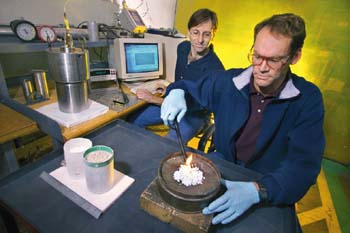 |
|
| Tim Kneafsey ignites a methane hydrate sample to demonstrate methane content while Barry Freifeld looks on. |
In the real world, methane hydr-ates are a latticework of water and methane that form an ice-like solid under high pressures and temperatures that hover just above freezing, conditions found in deep oceans and under Arctic permafrost. Scientists estimate the methane trapped in this crystalline mix may yield far more energy than the planet’s remaining reserves of fossil fuel.
“The big question is: can we produce hydrates as a resource?” says Kneafsey. To help answer this question, Kneafsey and fellow Earth Sciences Division researchers fabricated cylindrical hydrate samples that measure four inches in diameter and four inches high. These large samples will enable the team to study how methane hydrate dissociates, as well as how fluids flow through porous media containing the hydrates. They’ll also be able to explore other physical properties, such as methane hydrate’s thermal conductivity and its permeability to liquid and gas.
“Typically, scientists make tiny samples, but we want to make larger samples that offer a better idea of hydrate’s properties,” Kneafsey says.
In addition, the samples are fabricated in a way that closely mimics how methane hydrates are believed to form in the real world. The team takes an unsaturated, wet sample of sand, and introduces methane within the hydrate stability zone, meaning under high pressure and at a low temperature. Ultimately, tests performed using the samples will allow the team to refine numerical models that depict how methane hydrates behave in the real world.
Recent Awards and Honors
Bennett Among “50 Most Powerful” in Networking
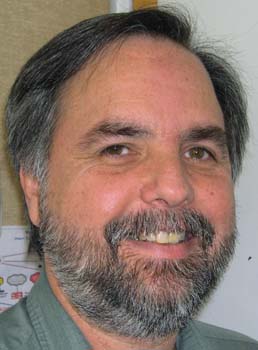 |
|
| Bennett | |
Michael Bennett, a senior engineer in Information Technology Services Division’s Networking and Telecommunications Department, has been named as one of the “50 Most Powerful People in Networking” by NetworkWorldFusion, a web-based magazine. Bennett’s selection puts him in some pretty prestigious company — the list also includes the heads of such companies as Cisco, IBM, Microsoft, SBC, Hewlett-Packard, Dell, Verizon, and others. Bennett is also one of just a handful of people from the public sector.
“It was a total surprise,” said Bennett, who learned about the recognition when a colleague sent a message congratulating him. “I didn’t have a clue this was coming. It’s somewhat overwhelming, but it feels good to be listed in a group that includes Bill Gates and John Chambers.”
Bennett said he wasn’t contacted in advance, but suspects his work for the Institute of Electrical and Electronics Engineers had something to do with it. He is involved with efforts to use 10 gigabit Ethernet technology over copper and develop related industry standards. In this role, he is frequently sought out by journalists looking for an end-user perspective to balance claims made by technology vendors.
Price Receives APS Fellowship
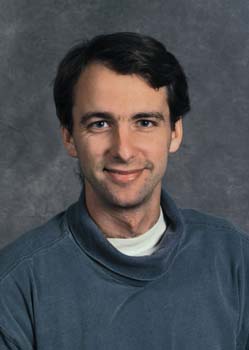 |
|
| Price |
Phillip Price — a scientist with the Environmental Energy Technologies Division’s Indoor Environment group — has been elected a fellow of the American Physical Society.
The fellowship program was created to recognize members who’ve made advances in knowledge through original research and publication or made significant and innovative contributions in the application of physics to science and technology.
They may also have made significant contributions to the teaching of physics or service and participation in the activities of the society.
Each year, no more than one-half of one percent of the current membership
of the society are recognized by their peers for election to the status
of Fellow in the American Physical Society.
EMPLOYEES SHOULD UPDATE ADDRESS OR NAME INFORMATION
Employees with an international address or without online access should contact their HR Center for assistance. Update requests should be made in writing, either by mail or e-mail.
HR Center contacts for employees in each Lab division or department include:
- Genomics and JGI:
- Jennifer Baltrons, (925) 296-5892, baltrons2@llnl.gov
Life Sciences:- Ewa Elkins, X2952, EAElkins@lbl.gov
Physical Biosciences:- > Carolyn Charles, X6619, CGcharles@lbl.gov
AFRD and Laboratory Directorate:- Marcus Davis, X4509, MDDavis@lbl.gov
Nuclear Science and Physics:- Neli Lopez, X4563, NLopez@lbl.gov
ASD/FSD and HR Departments:- Diana Attia, X7399, DMAttia@lbl.gov
Engineering:- Pamala Williams-Perkins, X4872, PWPerkins@lbl.gov
Facilities:- Deborah Martin, X5372, DIMartin@lbl.gov
Chemical Sciences and Material Sciences:- Sue Yoshioka, X6685, S_Yoshioka@lbl.gov
Earth Sciences and EH&S:- Amy Bennett-Lazaro, X6246, AMBennett@lbl.gov
EETD and ALS:- Cherryl Palomar Susara, X5683, CPSusara@lbl.gov
Computing Sciences:- Jamila Murray, X2747, JMMurray@lbl.gov
Flea Market Policy
Submissions must include name, affiliation, extension, and home phone. Ads must be submitted in writing
(e-mail: fleamarket@ lbl.gov, fax: X6641,) or mailed/delivered to Bldg. 65.
Ads run one issue only unless resubmitted, and are repeated only as space permits. The submission deadline for the Jan. 23 issue is Friday, Jan. 15.
Flea Market
- AUTOS & SUPPLIES
- ‘93 CAMARO, 58K mi, new tires 6 cyl, exc cond, no dents,
service records, ac, am/fm, electric win & dr locks, $4,300
firm, Dan, X4240
‘91 HONDA ACCORD DX, 63K mi, 5 speed, man trans, ac, 4 dr, good cond, $2,900/bo, Dan, X6382, 642-3502, or 548-4604
‘89 FORD PROBE GL, 2 dr hatchback, white, 5 sp man trans, 115K mi, good cond, runs well, lge cargo space, $1,000, Owen, X5462, 655-8498
‘88 TOYOTA CAMRY, 168K mi, good cond, 4 dr, sedan, blue, 5 sp man, avail 1/28, $1,700/bo, Alfredo, X4110, 524 0874
4 SNOW TIRES, free, Bridgestone 185/70R14, used for two winters & still like new, Mahiko, X4479
HOUSING- ALAMEDA, lge rm to share in 2 bdrm apt, DSL, hardwd floors, lge
storage area, close to shops/beach/trans, $600/mo incl utils, Victor,
814-8199
BERKELEY HILLS, house in wooded neighborhood, furn, 3 bdr/ 2 bths, lge kitchen, liv rm, din rm, study, priv yard, avail 3/1 to 9/15, $2,100/mo, Gisela, 841-2066, gisela101@prodigy.net
BERKELEY, furn rm in 4 bdrm house, 5 blocks to campus & Lab shuttle, on Euclid Ave nr Cedar, close to Rose Garden, tennis courts, view of SF, share w/ 2 visiting scholars, $650/mo, Lora, 548-1287
BERKELEY, 1 block to UC, furn 1 bdrm apt, hardwd floors, $1,575 incl PC, DSL & some util, 845-5959, jin.young@juno.com, Paul, X7363
CENTRAL BERKELEY, nice furn rms, kitchen, laundry, PC, DSL, hardwd floors, breakfast, walk to campus/shops, $950/mo incl everything, 845-5959, jin.young@juno.com, Paul, X7363
HAYWARD, nr state university, 2 bdrm house, yard, garage, $1,350/mo, Olga, 538-9132
NORTH BERKELEY, 1 bdrm upper flat, fully furn, nr Glendale & Campus Dr, carpeted, laundry, deck, fp, parking for 1 car, no pets/smok, $1,100/mo + dep & util, avail 1/11, Rochelle, (415) 435-7539
NORTH BERKELEY, furn studio avail 1/15, $750/mo, Rochelle, 883-0161
NORTH BERKELEY, med/lge room in 3 bdrm house, fully furn, close to Lab shuttle/BART, share kitchen & bth w/ me & 1 European employed woman, temp stay ok, 2 mo min, first & last mo rent upon move-in, rm has double bed, TV/VCR, phone connection, lge closet, bookshelves, desk, 3 bay windows, Karen, 525-6621
MISC ITEMS FOR SALE- BED, double, solid cherry, head & foot boards, exc cond,
matt/spring; oak dresser, 5 drawer; brass bed, double, head &
foot boards, matt/spring, exc cond; dresser, 3-drawer, lrg mirror,
good cond; b/o, Mark, X6581
MACINTOSH QUADRA 650 w/ keyboard & col monitor, $100, Vince, 237-7205
PANASONIC TV, CTG-2530, 25” color, video & audio jacks, quartz tuning, modern wood cabinet, exc picture, exc cond, $75; TV/VCR cart, Bush V335, 2 shelves, 2 glass doors, 31”x21”x20”, $35; TV swivel base, 24”x15”, $13, Ron, X4410, 276-8079
WANTED- ROOM needed for 3 mo beg 03/04, nr campus, visiting female grad student from Italy, X2792, hkoivunoro@lbl.gov, Hanna Koivunoro, X2792, 845-8971
VACATION- LAKE TAHOE, 3 bdrm/2-1/2 bth, fenced yard, quiet sunny location,
skiing nearby, great views of water/mountains, $195/night, 2 nights
min, Bob, (925) 945-9345